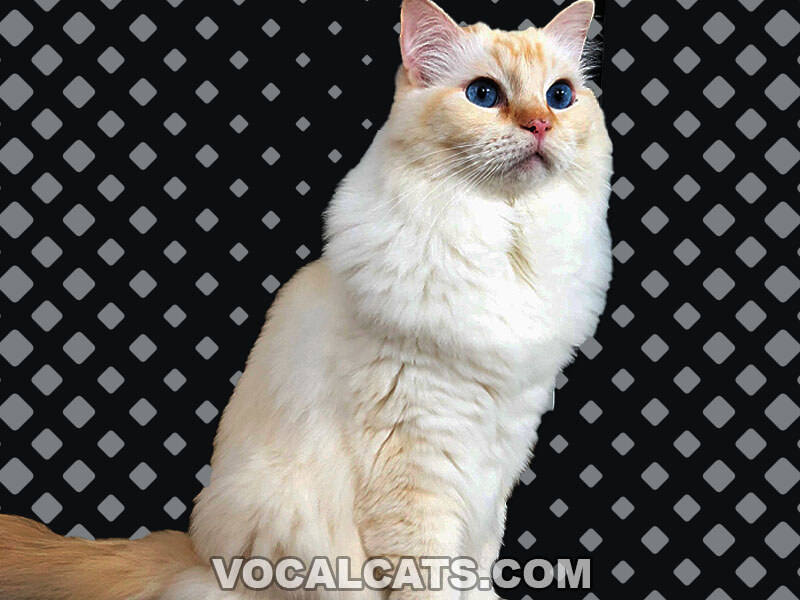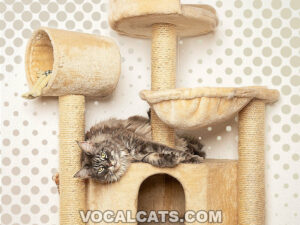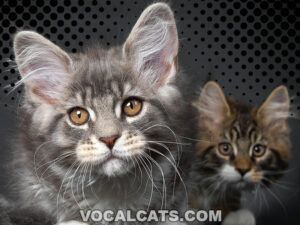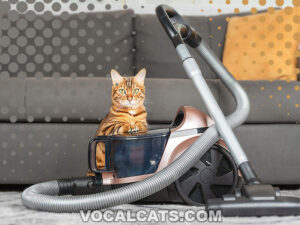Ragdolls are one of the most in-demand cat breeds in the world because of their lush, attractive fur and calm nature. The Red Ragdoll Cat is one color variation of the Ragdoll which we will tackle in this guide.
Red Ragdoll Cat, also known as the Flame Point Ragdoll or Cream Point Ragdoll, has red-orange fur on its points with white or pale cream fur on its body. The combination of creamy apricot with white, plus the blue eyes, make this color variation of the Ragdoll very attractive.
If you’re interested in the Red Ragdoll, you’ve landed on the right page. In this comprehensive guide, we will discuss everything you need to know about the Red Ragdoll Cat including their genetics, personality, common health issues, different coat patterns, and their grooming and dietary requirements.
Contents
- Red Ragdoll Cat: Breed overview
- What is a Red Ragdoll Cat?
- Red Ragdoll Cat genetics
- Are Red Ragdolls rare?
- Is Red a recognized Ragdoll Cat color?
- Red Ragdoll physical appearance
- Do all Red Ragdoll Cats have blue eyes?
- Why do Ragdoll Cats eyes go Red?
- Various Red Ragdoll Cat colors and patterns
- How does a Red Ragdoll Cat change color when his temperature is high?
- How does a Red Ragdoll Cat change color when his temperature is low?
- Long Haired Ragdoll Cat
- What is the difference between Red Point Ragdoll cats and Flame Point Ragdoll Cats?
- Ragdoll Red Hair size, height, and weight
- Are Red Ragdoll Cats darker in color when they are fat?
- Red Point Ragdoll personality and temperament
- Do Red Ragdoll Cats make good family pets?
- Are Red Point Ragdolls born Red?
- RedPoint Ragdoll training
- Red Ragdoll Cat exercise requirement
- Red Ragdoll grooming and cleaning
- Do Red Ragdoll Cats shed a lot?
- Are Red Ragdolls hypoallergenic?
- Ragdoll Red Hair food and diet
- Red Ragdoll Cat health issues
- Red Ragdoll Cat lifespan
- Red Ragdoll breeders
- Red Ragdoll Cat kitten
- Red Ragdoll Cat price
- Places to find Red Point Ragdoll kittens for sale
- Finding a healthy Red Ragdoll Cat for sale
- Red Ragdoll Cat: Pros and Cons
- Is the Red Ragdoll Cat right for me?
- Related Questions
Red Ragdoll Cat: Breed overview
Below is a brief description of the Red Ragdoll:
| Other names | Flame Point Ragdoll, Orange Ragdoll Cat, Ginger Ragdoll Cat |
| Size | Large |
| Weight | 8 – 20 pounds |
| Height | 9 – 11 inches |
| Coat Colors | Orange, Red, Cream, White, Apricot |
| Child Friendliness | High |
| Feline Friendliness | High |
| Training Difficulty | Moderate |
| Grooming Upkeep | Moderate – High |
| Exercise Needs | Low- Moderate |
| Health | Moderate |
| Lifespan | 12 – 16 years |
| Kitty Costs | $1,000 – $2,000 |
What is a Red Ragdoll Cat?
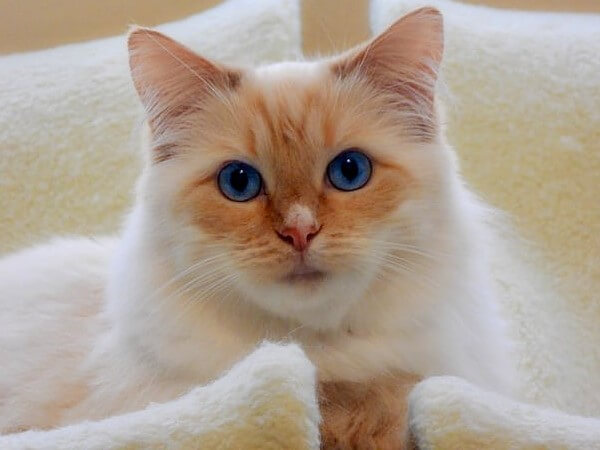
A Red Ragdoll Cat is a Ragdoll with red-orange points in the ears, mask, legs, and tail. Their coat color of the body is white with some shading of the same tone as their points. Cat aficionados also refer to them as Orange Ragdoll Cat or Flame Point Ragdolls.
Red Ragdoll Cat genetics
The gene that gives the Red Ragdoll its pheomelanin or red pigmentation is the dominant ‘O’ gene. It is attached to the X-chromosome. Since the male Ragdoll cat only has one X-chromosome, a dominant ‘O’ will produce an orange or red color.
The females, meanwhile, would need a dominant ‘O’ on each X-chromosome for her to be orange. Otherwise, she would have a black color making her a Calico Ragdoll or tortoiseshell (Tortie Ragdoll Cat).
Another gene that is controlling pigmentation in Ragdolls is the Cs gene. This gene produces a tyrosinase enzyme that allows hair follicles to produce dark pigmentation when the temperature is low. This is the reason why Ragdolls have dark points in the extremities where they are more exposed to the air than the body’s core.
Are Red Ragdolls rare?
No, Red Ragdolls are not rare although they are not very common. The most common and popular color of the Ragdoll is seal and blue. The rarest is lilac followed by chocolate.
Female Red Ragdolls, however, are harder to come by than males. This is because of the ‘O’ gene that is sex-linked, which was discussed above. It is estimated that 75% of orange or red cats are male.
DON’T MISS: Seal Point Ragdoll (Complete Guide)
Is Red a recognized Ragdoll Cat color?
Yes, Red is a recognized color of the Ragdoll as defined by the Cat Fanciers’ Association (CFA) and The International Cat Association (TICA). The other five (5) colors recognized are seal, chocolate, blue, lilac, and cream.
RECOMMENDED: Blue Point Ragdoll (Complete Guide)
Red Ragdoll physical appearance
Ragdoll Cat Red Point shares similar physical traits with all Ragdolls except for their color. They have a long and rectangular body structure with heavily-boned legs that are slightly longer in the rear. The chest is broad and the tail is long and furry.
The head is broad with widely set ears that are rounded at the tips. The eyes are oval-shaped with a slight slant and blue-colored.
They have a single coat that is medium-to-long in length and shows considerable thickness around the ruff.
Do all Red Ragdoll Cats have blue eyes?
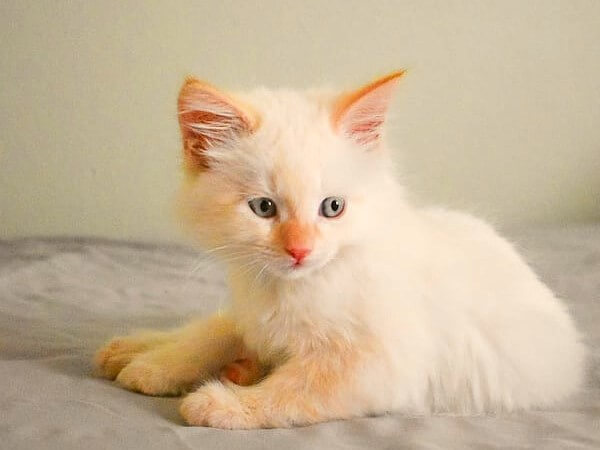
Yes, all Red Ragdoll Cats have blue eyes. This is one of the main physical characteristics of the Ragdoll. However, pale blue or very dark blue eye colors are considered a penalty in cat conformation shows.
You may be interested in: Blue Eyed White Ragdoll (Complete Guide)
Why do Ragdoll Cats eyes go Red?
There are several reasons why a Ragdoll’s eyes may turn red. Ragdoll Cat Red eyes are usually caused by either conjunctivitis or Keratoconjunctivitis Sicca (KCS).
Conjunctivitis is the inflammation of the mucous membrane that lines the surface of the eyeball. It can either be bacterial, viral, or parasitic. The condition might lead to swelling around the eyes and may discharge as well.
Keratoconjunctivitis Sicca, on the other hand, is the inflammation of the cornea due to dryness. It can cause swelling and white discharge as well, with severe cases leading to blindness.
Additionally, another reason why you might suddenly notice that you have a Red-eyed Ragdoll Cat is, strangely, because of their blue eyes.
Blue-eyed cats lack color in the layer of tissue in the eyes called tapetum lucidum. This lack produces a red eye effect when a light source hits the retina causing reflection of the red blood vessels. This is completely normal and should not be a cause for concern.
Various Red Ragdoll Cat colors and patterns
Red Point Ragdoll Cat comes in three (3) coat patterns depending on the distribution of their red color points, namely, Colorpoint, Mitted, and Bicolor. The points can either be solid in color or have distinct striping or ticking.
Red Point Ragdoll Cats typically have a white body coat with apricot to deep red points in the ears, mask, legs, and tail. This is the traditional Colorpoint description.
A Bicolor Red Ragdoll will have points restricted to the ears, face, tail, and back, which is called the saddle. The marking on the face is interrupted by an inverted white ‘V.’ The legs, chin, and belly are also white.
Red lynx point Ragdoll
Red Lynx Ragdoll Cats have white bodies with some red ghost striping or ticking. The points have deep red bars separated by lighter-colored fur. They have a distinctive ‘M’ pencil pattern on their forehead, and their ears are red with a paler red thumbprint in the center.
Red mitted Ragdoll Cat
Red Point Mitted Ragdoll Cat have points in the legs, except for the paws, and in the ears, face, and tail. The chin is white that extends to the underbelly. The front paws have white furs that extend to the ankle, while the back paws can have white furs that extend to mid-thigh.
Some Red Point mitted Ragdoll Cat exhibit a white blaze on their nose or forehead that is shaped like a diamond or hourglass.
Red cream Ragdoll Cat
Red and Cream Ragdoll Cat have a white body coat with some mottling of cream. Points are orange red with a mottling of cream as well. The paws and nose leather are pink.
Red and white Ragdoll Cat
Red and white Ragdoll Cat presents with a glacial white body coat and orange to red points in the ears, face, legs, and tail.
How does a Red Ragdoll Cat change color when his temperature is high?
Red Ragdoll Cat, as with all Ragdolls, have color pigmentation that is temperature-sensitive. Ragdolls will have a lighter color when their skin temperature is high.
Factors that can cause Red Ragdoll’s temperature to rise include:
- Change from cold to warm temperatures.
- Fever.
- Stress.
- Skin issues.
- Acute Inflammation.
- Digestive problems.
How does a Red Ragdoll Cat change color when his temperature is low?
Red Ragdoll Cat will have a redder body coat color and darker orange points when their temperature is low.
Factors that may cause a Red Ragdoll’s coat to be darker includes:
- Change from warm to colder temperatures.
- Liver or kidney ailments.
- Poor blood circulation.
- Cancer.
- Old Age.
- Skin issues.
- Weight gain.
Long Haired Ragdoll Cat
Ragdolls have medium to long hairs that is made up of guard hairs. They have little to no undercoat, but they do shed moderately.
What is the difference between Red Point Ragdoll cats and Flame Point Ragdoll Cats?
Red Point and Flame Point Ragdolls are the same. The term “flame” is used interchangeably with “red” when referring to the orange-colored Ragdoll.
Ragdoll Red Hair size, height, and weight
Ragdolls, as with the Ragdoll Cat Red, will reach their full size by the age of 3 to 4 years. They tend to grow in spurts as they mature compared to other cat breeds.
Here is the size, height, and weight chart of Red Ragdoll Cats:
| Height | Weight | Length | |
| Male | 9 – 11 inches | 12 – 20 pounds | 17 – 21 inches |
| Female | 7 – 9 inches | 8 – 15 pounds | 17 – 19 inches |
Are Red Ragdoll Cats darker in color when they are fat?
Yes, Red Ragdoll Cats tend to have a darker color in areas where there is more fatty deposit. Ragdolls of any color will get this condition because of a gene mutation linked to temperature-sensitive pigmentation. This is the same gene that controls the color points in their extremities. The cooler the body part is, the darker it would be.
When there are increased fatty deposits in the abdomen, chest, or back, the veins in these fatty tissues are fewer compared to their muscles. Lesser blood circulation causes a temperature drop in those areas causing the fur to turn darker.
The same mechanism works when they are just kittens. As kittens, their metabolism tends to be faster, therefore, their bodies are warmer and tend to be light in color. But, as they mature and metabolism slows, the dark color in the extremities will start to appear.
Red Point Ragdoll personality and temperament
Who wouldn’t get smitten by the charm of a Red Point Ragdoll cat? Not only are Red Ragdolls ravishingly gorgeous but they are also kind-hearted and sweet.
A word of caution though. Do not attempt to leave her alone outside of your home because she lacks the instinct to defend herself from aggressive pets. She is simply too nice and friendly to everyone even to potential catnappers.
Do Red Ragdoll Cats make good family pets?
Absolutely! A Red Ragdoll can be an excellent pet for children as she is playful and does not mind being held.
If you’ve got other pets at home, that’s not a problem because she will gets along fine with them.
If there is one problem that you might encounter with her, that is, a Red Ragdoll cannot be left alone in your home for more than 6 hours. Some owners even say the maximum time their Ragdolls can be alone is 4 hours!
Separation anxiety is real and it can result in unwanted behaviors like refusal to eat, excessive grooming, and in some cases, hiding from their owners.
Are Red Point Ragdolls born Red?
No, a true-blooded Red Ragdoll is born with white fur. You will see their colors gradually change by the time they reach 3 weeks of age. But, it is not until an average of 2 to 4 years before you can finally see their true colors.
RedPoint Ragdoll training
A RedPoint Ragdoll is such a joy to train because she is an obedient cat. One method to use is CPR which is short for command, praise, and reward.
Commands like sit, come, and high-five can be taught but make sure to give praise lavishly in the form of touch or treats. Be sure to only give treats in moderation to prevent her from getting obese.
Also, upon bringing her home, begin litter box training. On some days when she may not get it right, punishment is never an option. Be consistent with litter box training. Don’t worry too much because she will get it right sooner than you expect.
Red Ragdoll Cat exercise requirement
It can either be an annoyance or not because a Red Ragdoll can be described as a lazy cat which is good for owners who are too busy to exercise with their cats.
On the one hand, a lack of physical activity leads to health problems like obesity.
To strike a balance, owners like you can opt to play a game of fetch or play hide-and-seek inside your home for a Red Ragdoll’s minimal exercise requirements.
Red Ragdoll grooming and cleaning
One of the basic grooming requirements of a Red Ragdoll is frequent brushing. If not, don’t be surprised if you see and feel mats or tangles around the body.
You can use a de-shedding tool called Furminator because this product works well in preventing the formation of mats.
Bathe your Red Ragdoll once a month and be sure to use a mild and organic shampoo. Make sure to use lukewarm water. Gently pat your Red Ragdolls down until the fur gets dry or you may also use a hairdryer under low heat.
Below is a grooming table that you can follow to keep your cat clean and healthy.
| Grooming Needs | Grooming Frequency |
| Hair Brushing | 3 – 4x weekly. |
| Nail Trimming | As needed. |
| Teeth Brushing | 2 – 3x weekly. |
| Bathing | Once a month. |
| Eye Care | Check weekly. |
| Ear Care | Check weekly. |
Do Red Ragdoll Cats shed a lot?
Yes, Red Ragdoll Cats do shed. However, their shedding is considered moderate compared to other cat breeds. These cats have a soft, medium-length coat that requires consistent grooming to minimize shedding and keep it in good condition.
Although their shedding is not as heavy as other cat breeds, you can still expect to see some shedding.
Red Ragdolls shed most during seasonal changes when they shed their winter or summer coats.
To help control and reduce your Red Ragdoll Cat’s shedding, it is essential to brush them regularly, ideally three or four times a week. You’ll want to use a high-quality brush or comb that’s designed for long-haired cats.
So why is regular grooming crucial?
Because regularly grooming your Ragdolls can help remove loose hairs, prevent mats and tangles, and distribute natural oils throughout their coat.
Additionally, providing a balanced diet and maintaining a clean living environment can contribute to a healthier coat and reduced shedding.
Another way many cat parents control and reduce the amount of fur and dander in their home is by vacuuming at least once a week.
We highly recommend getting a powerful vacuum cleaner with HEPA filters. HEPA stands for High-Efficiency Particulate Air.
Investing in a vacuum cleaner with HEPA filters will offer several significant benefits in maintaining a clean and healthy living environment:
- Improved air quality: HEPA filters are designed to capture very small particles, including pet dander, hair, dust, pollen, and mold spores. By trapping these allergens, you’ll have cleaner air inside your home. This can help you and your pets breathe easier.
- Effective allergen removal: Cat dander is a common allergen that can trigger allergic reactions in sensitive individuals. Vacuum cleaners with HEPA filters are highly effective at capturing and removing pet dander, which can help reduce the allergens in your home and minimize allergy symptoms.
- Prevention of respiratory issues: By effectively removing allergens and airborne particles, vacuum cleaners with HEPA filters can help prevent respiratory issues such as asthma or other breathing difficulties.
- Enhanced cleaning performance: Vacuum cleaners with HEPA filters generally provide better cleaning performance. They can capture much smaller particles than standard vacuum filters. This ensures a more thorough cleaning of your home, removing not only visible debris but also microscopic allergens that can affect you and your cat’s health.
By taking the steps above, you can manage your Red Ragdoll’s shedding and keep their fur in top condition.
WANT MORE INFORMATION? Check out Do Ragdoll Cats Shed? 7 Ways To Shed Less!
Are Red Ragdolls hypoallergenic?
No, Red Ragdolls are not hypoallergenic. It’s important to note that no cat breed is 100% hypoallergenic, including Red Ragdolls.
Hypoallergenic cats are believed to produce fewer allergens than other cats, which makes them more suitable for people with cat allergies.
However, it’s worth mentioning that individual reactions to cat allergens can vary greatly. No cat breed can guarantee that a person with cat allergies won’t experience any symptoms.
The primary allergen responsible for cat allergies is a protein called Fel d 1. It is produced in a cat’s skin, saliva, and sebaceous glands. Although some cat breeds are thought to produce less Fel d 1, there is no definitive evidence to suggest that Ragdoll cats, including Red Ragdolls, are hypoallergenic.
If you have cat allergies and are considering getting a Red Ragdoll or any other cat, it’s a good idea to spend time around cats to see how your allergies are affected.
Additionally, you can take steps to reduce allergens in your home by cleaning more frequently, using air purifiers with HEPA filters, and regularly grooming your cat.
RECOMMENDED: Are Ragdoll Cats Hypoallergenic?
Ragdoll Red Hair food and diet
In the next section, you will learn that Ragdoll Red is vulnerable to kidney and bladder health problems.
That said, the best choice is canned or wet feline food for cats for its higher moisture level. It’s fine to give dry cat food but mix it with canned food. This is because higher hydration is the only way to prevent kidney and bladder issues.
Red Ragdoll Cat health issues
The good news is that Red Ragdolls are generally healthy. However, can be prone to certain health issues (which we will discuss in detail below). When it comes to their cat’s health, many cat parents rely on the cat DNA testing kit.
So why is cat DNA testing kit crucial?
A cat DNA testing kit helps identify genetic health issues for early intervention and management. These tests also inform breeding decisions. This allows for personalized care for your cat’s specific needs.
Early identification of genetic health risks enables many cat parents to take proactive steps to ensure their precious kitties live a healthier and happier life.
To better care for your Red Ragdoll, here are five (5) common health issues that are associated with the breed and the symptoms to look out for:
1. Dental Problems
Infected gums and loose teeth are commonly diagnosed among older Red Ragdolls. These dental problems will eventually affect your cat’s eating and drinking behavior, thus, weakening the immune system. Signs to look for are foul breath and a change in gum color.
2. Obesity
Due to a Red Ragdoll’s laid-back personality, any increase in food intake could lead to weight gain. If you fail to correct his weight, obesity can be the cause of feline diabetes.
3. Polycystic Kidney Disease
Ragdolls are known to have a lesser level of kidney cells which makes them very susceptible to cysts in the kidneys. This disease is progressive that would, later on, affect metabolism and sugar levels. The common signs are increased thirst and urination.
4. Urinary Tract Infection
This is caused by bacteria in the urethra and the bladder. The symptoms are foul-smelling urine and urine leaking.
5. Inflammatory Bowel Disease
This is caused by an inflammation in the stomach, the common signs are blood in the stool and constipation.
Red Ragdoll Cat lifespan
A cat breed that has a long lifespan of 12 to 16 years.
Red Ragdoll breeders
Here are some of the characteristics of ethical Red Ragdoll breeders:
- They are members of local and international cat associations.
- They are open to welcoming buyers into their breeding facilities.
- They raise their cats in an underfoot environment, meaning, they are permitted to move freely in their homes and treated like family members.
- They perform a health check before releasing the kitties to new owners.
Red Ragdoll Cat kitten
Now that you’re ready to enjoy the company of a Red Ragdoll kitten, make sure that you’ve prepared the following items he needs. These are the following:
- Food and drinking bowls.
- A soft and comfortable kitty bed.
- Cat carrier.
- Collar and leash.
- Toys.
- Litter box with kitten-safe litter sand.
Red Ragdoll Cat price
The average price is between $1,000 and $2,000.
Places to find Red Point Ragdoll kittens for sale
Red Ragdoll kittens are not rare but they are hard to come by. You can check out these two (2) reputable breeders and see if they have a waitlist for Red Ragdoll kittens for sale.
RocknRed Ragdolls or Rockin Red Ragdolls (rnrragdolls.com/availability) have an available male Red Ragdoll kitten for sale in their North Carolina branch. Do not hesitate to call the breeder for the price.
You can also visit the website of USA Ragdolls (usaragdolls.com/ragdoll-kittens-for-sale) and check if there will be an available Red Ragdoll kitten for sale again in the near future.
Finding a healthy Red Ragdoll Cat for sale
For adult cats, we’d like to connect you with two (2) trusted breeders who could have a retired Red Point Ragdoll Cat for sale.
You may want to explore the website of Rock Creek Ranch Ragdolls (rockcreekranchragdolls.com) because they occasionally have retired adult cats for sale.
If you are in the UK, check out Fluffi Ragdolls (fluffidolls.co.uk) for available Red Ragdoll Cats for sale. You can fill out an online application form and indicate the color and age of Ragdolls you want to buy.
Red Ragdoll Cat: Pros and Cons
To recap on what to expect from a Red Ragdoll cat, here is a table of the pros and the cons of this gentle giant cat breed.
| Pros | Cons |
| People-oriented. | Not hypoallergenic. |
| Can easily learn obedience training and cat tricks. | Sheds her fur moderately. |
| Friendly to children. | Owners need to brush her fur often to avoid mats from forming. |
| Can live peacefully with other animals. | Owners may have to vacuum more frequently to get rid of cat fur around their house. |
| Not very active. | Pricy. |
| Not very noisy. | Prone to feline-obesity. |
Is the Red Ragdoll Cat right for me?
If you are someone who is looking for a feline companion with a puppy-like demeanor and is good with kids, then yes, a Red Ragdoll is right for you. Just be sure not to leave him for more than four hours without human companionship.
Related Questions
Yes, you can get a Ginger Ragdoll Cat. A Ginger Ragdoll Cat is also the same as an Orange or Flame Point Ragdoll. Some just use the terms interchangeably.
The rarest Ragdoll Cat is the Lilac Ragdoll, which carries the two (2) recessive diluted genes, one of which is the chocolate recessive dilute gene.
DISCLAIMER: THIS WEBSITE DOES NOT PROVIDE MEDICAL ADVICE
The information, including but not limited to, text, graphics, images and other material contained on this website are for informational purposes only. No material on this site is intended to be a substitute for professional veterinary advice, diagnosis, or treatment. Always seek the advice of your veterinarian or other qualified health care provider with any questions you may have regarding a medical condition.
Resources:
https://en.wikipedia.org/wiki/Ragdoll
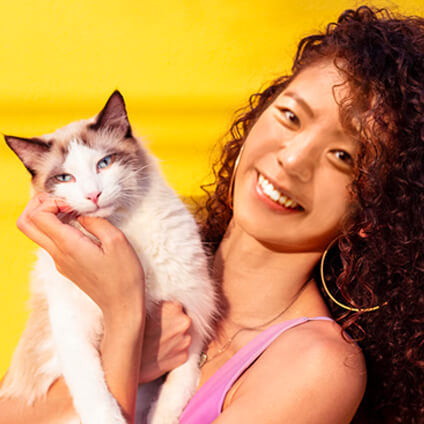
With over five years of specialized experience as an animal writer, my expertise lies in cat nutrition, health, behavior, grooming, and training. I am dedicated to delivering helpful and informative content that caters to the well-being of our feline friends. My primary goal is to empower pet owners with knowledge and ensure our feline companions thrive in health and happiness. In my free time, I love volunteering at local cat rescue centers.
